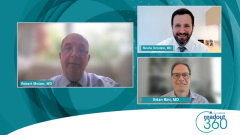
Pembrolizumab Plus Axitinib Versus Sunitinib for First-Line Treatment of Advanced Clear Cell RCC
Brian Rini, MD, reviews data from the 5-year analysis of the KEYNOTE-426 trial in advanced clear cell renal cell carcinoma.
Episodes in this series

Robert Motzer, MD: I'd now like to turn it over to Dr Brian Rini to report the results for the long-term follow-up for the pembrolizumab + axitinib versus sunitinib KEYNOTE-426 trial.
Brian Rini, MD: Thanks, Bob. So, it's my pleasure to present these data. KEYNOTE-426 was the first of the IO/TKI trials to report out and so it was the longest follow-up. And at this year's ASCO we presented a minimum five-year follow-up. So, these IO/TKI regimens are finally starting to get some long-term follow-up. The study design was very similar to the other phase 3s advanced, previously untreated clear cell kidney cancer stratified by IMDC and geography and then randomized equally to the control arm of sunitinib monotherapy or pembrolizumab and axitinib, the IO/TKI combo and the primary endpoints were both overall survival and PFS with the usual secondary endpoints. So, this study initially showed, I guess, now, almost four years ago, the initial report, which was a one-year follow-up, showed a striking survival benefit hazard ratio 0.53, as well as PFS and response rate benefits. There were two subsequent analyses with approximately two and three-year minimum follow-up. And at this year's ASCO, there was an additional two years of follow-up i.e., five-year minimum. Not surprisingly, some of the early sort of tumor shrinkage endpoints were preserved. So, progression-free survival continued to show an advantage of about 16 versus 11 months median. Hazard ratio 0.69, and this persisted after pembrolizumab was stopped in two years. And in all the IO/TKI trials, the immune therapy was stopped at two years and there seems to be a persistence of the PFS benefit now three years after that time point. The overall survival also continued to favor the combination medium about 48 versus 41 months hazard ratio of 0.84 which is a little higher than previous reports and I think reflects the subset of patients and there are about 30% favorable risk in this particular study that went on to receive subsequent treatment and we know from data presented that the vast majority of sunitinib patients not only went on to subsequent treatment in multiple lines, but 80% received a checkpoint inhibitor. So, it really reflects that sequence of therapies.
Robert Motzer, MD: So those were really exciting and thought-provoking results. Dr Ornstein, maybe you can comment in terms of kind of what was your take on these data, and did you find these important or what were your kind of thoughts about kind of the bottom line for these presentations?
Moshe Ornstein, MD: I think it's critical to have these long-term follow-ups from the IO/TKI studies. Now, in general, treatment of treatment-naive clear cell RCC is broken down into these broad categories of patients getting IO/IO with ipi-nivo or one of the approved IO/TKI regimens and the ipi-nivo patients and the CheckMate 214 study does have a long-term follow-up being the first IO based combination approved for the treatment of treatment-naive clear cell RCC. And it's always been this debate whether the IO/TKI regimens would have a so-called tail of the curve or if the benefit of IO/TKI is limited to those TKI upfront benefits of response rates and PFS. So, to see both in the clear study of lenvatinib + pembrolizumab and in the KEYNOTE-426 study of axitinib + pembrolizumab starting to see these long-term four- and five-year follow-ups where we're seeing patients still progression-free. We're seeing high percentages of patients still alive with these extended follow-ups tells us that there will be a long-term benefit for subsets of patients who get IO/TKIs as well. So, I don't know that this tells me that there is a major difference in the long-term analysis of lenvatinib and pembrolizumab versus axitinib and pembrolizumab. But it's reassuring to see that for these patients who have that upfront benefit of high response rates and strong PFS with the IO/TKI combinations, that there is a long-term benefit as well for this population.
Newsletter
Stay up to date on recent advances in the multidisciplinary approach to cancer.


























































































